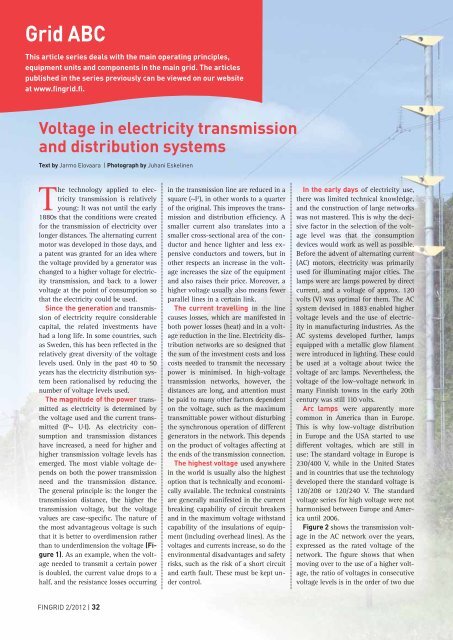2/2012 - Fingrid
2/2012 - Fingrid
2/2012 - Fingrid
You also want an ePaper? Increase the reach of your titles
YUMPU automatically turns print PDFs into web optimized ePapers that Google loves.
Grid ABCThis article series deals with the main operating principles,equipment units and components in the main grid. The articlespublished in the series previously can be viewed on our websiteat www.fingrid.fi.Voltage in electricity transmissionand distribution systemsText by Jarmo Elovaara | Photograph by Juhani EskelinenThe technology applied to electricitytransmission is relativelyyoung: It was not until the early1880s that the conditions were createdfor the transmission of electricity overlonger distances. The alternating currentmotor was developed in those days, anda patent was granted for an idea wherethe voltage provided by a generator waschanged to a higher voltage for electricitytransmission, and back to a lowervoltage at the point of consumption sothat the electricity could be used.Since the generation and transmissionof electricity require considerablecapital, the related investments havehad a long life. In some countries, suchas Sweden, this has been reflected in therelatively great diversity of the voltagelevels used. Only in the past 40 to 50years has the electricity distribution systembeen rationalised by reducing thenumber of voltage levels used.The magnitude of the power transmittedas electricity is determined bythe voltage used and the current transmitted(P~ U·I). As electricity consumptionand transmission distanceshave increased, a need for higher andhigher transmission voltage levels hasemerged. The most viable voltage dependson both the power transmissionneed and the transmission distance.The general principle is: the longer thetransmission distance, the higher thetransmission voltage, but the voltagevalues are case-specific. The nature ofthe most advantageous voltage is suchthat it is better to overdimension ratherthan to underdimension the voltage (Figure1). As an example, when the voltageneeded to transmit a certain poweris doubled, the current value drops to ahalf, and the resistance losses occurringin the transmission line are reduced in asquare (~I 2 ), in other words to a quarterof the original. This improves the transmissionand distribution efficiency. Asmaller current also translates into asmaller cross-sectional area of the conductorand hence lighter and less expensiveconductors and towers, but inother respects an increase in the voltageincreases the size of the equipmentand also raises their price. Moreover, ahigher voltage usually also means fewerparallel lines in a certain link.The current travelling in the linecauses losses, which are manifested inboth power losses (heat) and in a voltagereduction in the line. Electricity distributionnetworks are so designed thatthe sum of the investment costs and losscosts needed to transmit the necessarypower is minimised. In high-voltagetransmission networks, however, thedistances are long, and attention mustbe paid to many other factors dependenton the voltage, such as the maximumtransmittable power without disturbingthe synchronous operation of differentgenerators in the network. This dependson the product of voltages affecting atthe ends of the transmission connection.The highest voltage used anywherein the world is usually also the highestoption that is technically and economicallyavailable. The technical constraintsare generally manifested in the currentbreaking capability of circuit breakersand in the maximum voltage withstandcapability of the insulations of equipment(including overhead lines). As thevoltages and currents increase, so do theenvironmental disadvantages and safetyrisks, such as the risk of a short circuitand earth fault. These must be kept undercontrol.In the early days of electricity use,there was limited technical knowledge,and the construction of large networkswas not mastered. This is why the decisivefactor in the selection of the voltagelevel was that the consumptiondevices would work as well as possible.Before the advent of alternating current(AC) motors, electricity was primarilyused for illuminating major cities. Thelamps were arc lamps powered by directcurrent, and a voltage of approx. 120volts (V) was optimal for them. The ACsystem devised in 1883 enabled highervoltage levels and the use of electricityin manufacturing industries. As theAC systems developed further, lampsequipped with a metallic glow filamentwere introduced in lighting. These couldbe used at a voltage about twice thevoltage of arc lamps. Nevertheless, thevoltage of the low-voltage network inmany Finnish towns in the early 20thcentury was still 110 volts.Arc lamps were apparently morecommon in America than in Europe.This is why low-voltage distributionin Europe and the USA started to usedifferent voltages, which are still inuse: The standard voltage in Europe is230/400 V, while in the United Statesand in countries that use the technologydeveloped there the standard voltage is120/208 or 120/240 V. The standardvoltage series for high voltage were notharmonised between Europe and Americauntil 2006.Figure 2 shows the transmission voltagein the AC network over the years,expressed as the rated voltage of thenetwork. The figure shows that whenmoving over to the use of a higher voltage,the ratio of voltages in consecutivevoltage levels is in the order of two dueFINGRID 2/<strong>2012</strong> | 32

















